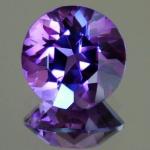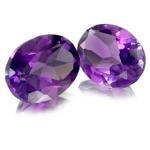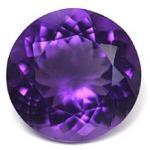
Classes- Alabama
- Alaska
- Arizona
- Arkansas
- California
- Colorado
- Connecticut
- Delaware
- Florida
- Georgia
- Hawaii
- Idaho
- Illinois
- Indiana
- Iowa
- Kansas
- Kentucky
- Louisiana
- Maine
- Maryland
- Massachusetts
- Michigan
- Minnesota
- Mississippi
- Missouri
- Montana
- Nebraska
- Nevada
- New Hampshire
- New Jersey
- New Mexico
- New York
- North Carolina
- North Dakota
- Ohio
- Oklahoma
- Oregon
- Pennsylvania
- Rhode Island
- Tennessee
- Texas
- Utah
- Vermont
- Virginia
- Washington
- West Virginia
- Wisconsin
- Wyoming
| Hardness : 7 Specific Gravity : 2.65 Refractive index : 1.54 - 1.5 Doubly Refracting (bi-refraction) : 0.009 In the 20th century, the color of amethyst was attributed to the presence of manganese. However, since it is capable of being greatly altered and even discharged by heat, the color was believed by some authorities to be from an organic source. Ferric thiocyanate was suggested, and sulfur was said to have been detected in the mineral. On exposure to heat, amethyst generally becomes yellow, and much of the citrine, cairngorm, or yellow quartz of jewelry is said to be merely (burnt amethyst). Veins of amethystine quartz are apt to lose their color on the exposed outcrop. Amethyst is composed of an irregular superposition of alternate lamellae of right-handed and left-handed quartz. It has been shown that this structure may be due to mechanical stresses. As a consequence of this composite formation, amethyst is apt to break with a rippled fracture, or to show (thumb markings), and the intersection of two sets of curved ripples may produce on the fractured surface a pattern something like that of (engine turning). Some mineralogists, following Sir David Brewster, apply the name of amethyst to all quartz which exhibits this structure, regardless of color. Because it has a hardness of 7 on the Mohs scale, amethyst is treasured for its use in jewelry. However, it is still just 1/15 as hard as diamond. Amethyst was used as a gemstone by the ancient Egyptians and was largely employed in antiquity for intaglios. Beads of amethyst are found in Anglo-Saxon graves in England. It is a widely distributed mineral, but fine, clear specimens that are suitable for cutting as ornamental stones are confined to comparatively few localities. Such crystals occur either in the cavities of mineral-veins and in granitic rocks, or as a lining in agate geodes. A huge geode, or (amethyst-grotto(, from near Santa Cruz in southern Brazil was exhibited at the Düsseldorf Exhibition of 1902. Many of the hollow agates of Brazil and Uruguay contain a crop of amethyst crystals in the interior. Much fine amethyst comes from Russia, especially from near Mursinka in the Ekaterinburg district, where it occurs in drusy cavities in granitic rocks. Many localities in India yield amethyst; and it is found also in Sri Lanka, chiefly as pebbles. Due to its popularity as a gemstone, several descriptive terms have been coined in the gem trade to describe the varying colors of amethyst. (Rose de France( is usually a pale pinkish lavender or lilac shade (usually the least sought color). The most prized color is an intense violet with red flashes and is called (Siberian), although gems of this color may occur from several locations other than Siberia, notably Uruguay and Zambia. In more recent times, certain gems (usually of Bolivian origin) that have shown alternate bands of amethyst purple with citrine orange have been given the name ametrine. Purple corundum, or sapphire of amethystine tint, is called Oriental amethyst, but this expression is often applied by jewelers to fine examples of the ordinary amethystine quartz, even when not derived from eastern sources. Professional gemological associations, such as the Gemological Institute of America (GIA) or the American Gemological Society (AGS), discourage the use of the term (Oriental amethyst) to describe any gem, as it may be misleading. Amethyst occurs at many localities in the United States, but these specimens are rarely fine enough for use in jewelry. Among these may be mentioned Amethyst Mountain, Texas; Yellowstone National Park; Delaware County, Pennsylvania; Haywood County, North Carolina; and Deer Hill, and Stow, Maine. It is found also in the Lake Superior district. Amethyst is relatively common in northwestern Ontario, but uncommon elsewhere in Canada; it was selected as the provincial mineral of Ontario in 1975. Amethyst is the birthstone associated with February. It is also associated with the Astrological signs of Pisces, Aries (especially the violet and purple variety), Aquarius, and Sagittarius. It is a symbol of heavenly understanding, and of the pioneer in thought and action on the philosophical, religious, spiritual and material planes. Ranking members of the Roman Catholic Church traditionally wear rings set with a large amethyst as part of their office. The Greek word (amethystos) basically can be translated as (not drunken.) Amethyst was considered to be a strong antidote against drunkenness, which is why wine goblets were often carved from it. Supposedly, when a drunken Dionysus was pursuing a maiden called Amethystos, who refused his affections, she prayed to the gods to remain chaste. The goddess Artemis granted the prayer, transforming her into a white stone; humbled by Amethystos' desire to remain chaste, Dionysus poured wine over the stone she had become as an offering, dying the crystals purple. Or: (The legend of the origin of amethyst comes from Greek myths. Dionysius, the god of intoxication, was angered one day by an insult from a mere mortal and swore revenge on the next mortal that crossed his path, creating fierce tigers to carry out his wish. Along came unsuspecting Amethyst, a beautiful young maiden on her way to pay tribute to the goddess Diana. Diana turned Amethyst into a stature of pure crystalline quartz to protect her from the brutal claws. Dionysus wept tears of wine in remorse for his action at the sight of the beautiful statue. The god's tears stained the quartz purple, creating the gem we know today.) |
- Birth Stone Gems
- Wedding & Anniversary Gems
- How To Guides
- Fireable Gems
- Nonprofits and Guilds
- Gem Show
- Gem Stone Information
- ·Abalone
- ·Achroite (Tourmaline)
- ·Agate ( Chalcedony)
- ·Alexandrite
- ·Almandine ( Garnet )
- ·Amber
- ·Amethyst ( Quartz)
- ·Ammolite
- ·Andalusite
- ·Andradite Garnet
- ·Apatite
- ·Aquamarine ( Beryl )
- ·Aventurine ( Quartz )
- ·Azurite
- ·Benitoite
- ·Bloodstone ( Chalcedony )
- ·Brown Quartz ( Smokey Quartz )
- ·Calcite
- ·Carnelian ( Chalcedony )
- ·Cassiterite
- ·Celestine
- ·Cerussite
- ·Chalcedony
- ·Chatoyant Quartz
- ·Chrysoberyl
- ·Chrysocolla
- ·Chrysoprase (Chalcedony)
- ·Citrine ( Quartz )
- ·Coral
- ·Danburite
- ·Diamond
- ·Diopside
- ·Dioptase
- ·Dravite ( Tourmaline)
- ·Emerald ( Beryl )
- ·Enstatite
- ·Epidote
- ·Euclase
- ·Fire Agate (Chalcedony)
- ·Fluorite
- ·Gold
- ·Goshenite (Beryl)
- ·Grossular Garnet (Tsavorite Garnet)
- ·Gypsum
- ·Heliodor ( Beryl )
- ·Hematite
- ·Hessonite (Grossular Garnet)
- ·Imperial Topaz
- ·Indicolite ( Tourmaline)
- ·Iolite
- ·Ivory
- ·Jadeite
- ·Jasper (Chalcedony)
- ·Jet
- ·Kornerupine
- ·Kunzite
- ·Kyanite
- ·Labradorite
- ·Lapis Lazuli ( Lazurite)
- ·Lazulite
- ·Malachite
- ·Meerschaum
- ·Microcline
- ·Milky Quartz
- ·Moonstone
- ·Morganite ( Beryl)
- ·Nephrite ( Jade)
- ·Obsidian
- ·Oligoclase
- ·Onyx
- ·Opal
- ·Orthoclase
- ·Padparasha ( Corundum)
- ·Pearl
- ·Peridot
- ·Pink Topaz ( Mercury Myst Vapor )
- ·Plasma ( Chalcedony)
- ·Prase ( Chalcedony )
- ·Prehnite
- ·Pyrite
- ·Pyrope ( Garnet )
- ·Rock Crystal ( Quartz )
- ·Rubellite ( Tourmaline)
- ·Ruby ( Corundum)
- ·Sapphire ( Corundum)
- ·Sardonyx ( Chalcedony)
- ·Scapolite
- ·Schorl (Tourmaline)
- ·Shell
- ·Spessarite (Garnet)
- ·Sphalerite
- ·Spinel
- ·Spodumene (Hiddenite - Triphane)
- ·Tanzanite (Zoisite)
- ·Tektites ( Moldavite )
- ·Tiger Eye
- ·Titanite (Sphene)
- ·Topaz
- ·Turquoise
- ·YAG (Garnet)
- ·Zircon


